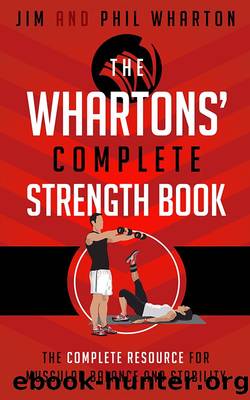The Whartonsâ Complete Strength Book by Jim & Phil Wharton

Author:Jim & Phil Wharton
Language: eng
Format: epub
Publisher: Jim and Phil Wharton
Published: 2014-01-15T00:00:00+00:00
Horseback Riding
To Strengthen: Upper Legs, Hips, and Trunk 1-15
Shoulders 16-25
Neck 26
Arms, Elbows, Wrists, and Hands 27-30
Coachesâ Notes
In all the world of sports, horseback riding is unique in that your success as an athlete directly depends on the performance of a partner who weighs ten times more than you do, but has only one-tenth of your intelligence, and is a prey animal whoâs only defense is to run. Contrasts notwithstanding, riders and horses have been âmatches made in heavenâ for more than five thousand years of recorded history. Today, as it has always been, horseback riding is as much a love affair as it is a sport. In this relationship, you might perform as a single unit, but there are two athletes to consider in all aspects of your work together.
Safety is the prime directive. We find it chilling that, unlike most other sports, the research published on horseback riding injuries is focused not on biomechanical mistakes, but on trauma caused by accidents. This is a dangerous sport for both rider and horse. The very act of riding is to perch a rider in the saddle. Itâs a balancing act that changes second by second. Stability is a fragile illusion, because gripping the saddle with your knees, pressuring the stirrups with your feet, and settling into your center of gravity do NOT cement you into position. One stumble and youâre on the ground. The great irony is that, when you mount your horse, your most vulnerable point (that one on top of your head) is the farthest from the ground and gains the most momentum on its way down. For this reason, we insist that you wear protective headgear at all times. A ten-gallon hat might look sexy, but its shockabsorbing capabilities are more shocking than absorbing. A helmet will help protect you from head trauma. And speaking of equipment, safety is directly linked to tack thatâs in good condition. Tack suffers a lot of wear and tear, so youâll want to inspect yours every time you use it. Regular maintenance and replacement of worn gear should be high priorities. By the way, equestrian statisticians point out that one can be injured in a horseback riding accident without even being on the horse. For example, the horse can step on a person or mash him against the fence or bite him on the arm, orâfrankly, the list is as endless as the possibilities presented by a one-ton horse dancing around a careless buckaroo.
Horseback riders tend to be in good shape not because riding is such a good workout, but because taking care of horses is hard work and keeps a person active on a daily basis. But not everyone is fortunate enough to get to work that hard. If youâre boarding your horse and letting someone else have all the fun, youâll need to consider supplemental fitness work. Although most riders tend to be strong in their legs and hips, they are notoriously underdeveloped in the upper body, shoulders, and arms. (News flash.
Download
This site does not store any files on its server. We only index and link to content provided by other sites. Please contact the content providers to delete copyright contents if any and email us, we'll remove relevant links or contents immediately.
Periodization Training for Sports by Tudor Bompa(8171)
Bodyweight Strength Training by Jay Cardiello(7843)
Born to Run: by Christopher McDougall(7065)
Inner Engineering: A Yogi's Guide to Joy by Sadhguru(6728)
Asking the Right Questions: A Guide to Critical Thinking by M. Neil Browne & Stuart M. Keeley(5649)
The Fat Loss Plan by Joe Wicks(4850)
Bodyweight Strength Training Anatomy by Bret Contreras(4614)
Yoga Anatomy by Kaminoff Leslie(4307)
Dynamic Alignment Through Imagery by Eric Franklin(4118)
Science and Development of Muscle Hypertrophy by Brad Schoenfeld(4089)
ACSM's Complete Guide to Fitness & Health by ACSM(3989)
Exercise Technique Manual for Resistance Training by National Strength & Conditioning Association(3957)
The Four-Pack Revolution by Chael Sonnen & Ryan Parsons(3932)
Bodyweight Strength Training: 12 Weeks to Build Muscle and Burn Fat by Jay Cardiello(3919)
The Ultimate Bodybuilding Cookbook by Kendall Lou Schmidt(3886)
Yoga Anatomy by Leslie Kaminoff & Amy Matthews(3863)
American Kingpin by Nick Bilton(3759)
Nutrition for Sport, Exercise, and Health by Spano Marie & Kruskall Laura & Thomas D. Travis(3715)
Yoga Therapy by Mark Stephens(3704)
